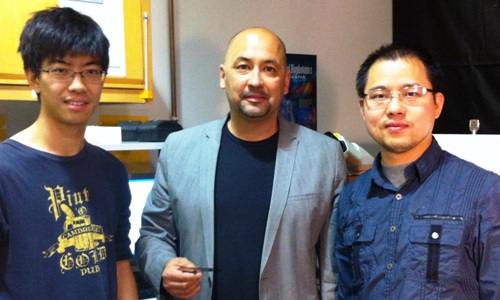A research team from the University of California, Riverside Bourns College of Engineering has developed a cooling technique using graphene multilayers to remove heat from gallium nitride, a semiconductor material utilized in various applications ranging from electric cars to traffic lights.

Alexander Balandin, center, stands with two of his graduate students, Guanxiong Liu (left) and Zhong Yan (right) (credit: University of California, Riverside)
This novel technique paves the way to expand the market share and applications of gallium nitride electronics. The Nano-Device Laboratory research team headed by Alexander Balandin has shown that the implementation of alternative heat-escaping channels using graphene multilayers were able to lower the temperature of hot spots in gallium nitride transistors by up to 20°C.
This reduction in temperature achieved through the use of graphene, a superior heat conductor, can increase the operating life of the transistor by a factor of 10, a breakthrough transformation in thermal management.
Contrary to semiconductor or metal films, few-layer graphene films can retain their superior thermal properties even at a thickness of few nanometers. The research team designed and implemented graphene-graphite ‘quilts’ atop gallium nitride transistors. Unlike traditional quilts, the graphene-graphite quilts’ purpose was to take away the heat from the hot spots and spread.
The research team used micro-Raman spectroscopic thermometry to show that the hot spots’ temperature can be reduced by 20°C in gallium nitride transistors that operate at the higher power levels. Using computer simulations, the team discovered that the performance of graphene quilts can be higher in gallium nitride transistors on substrates that have high thermal resistance.
The study results have been reported in the journal, Nature Communications.
Source: http://www.ucr.edu/
Disclaimer: The views expressed here are those of the author expressed in their private capacity and do not necessarily represent the views of AZoM.com Limited T/A AZoNetwork the owner and operator of this website. This disclaimer forms part of the Terms and conditions of use of this website.